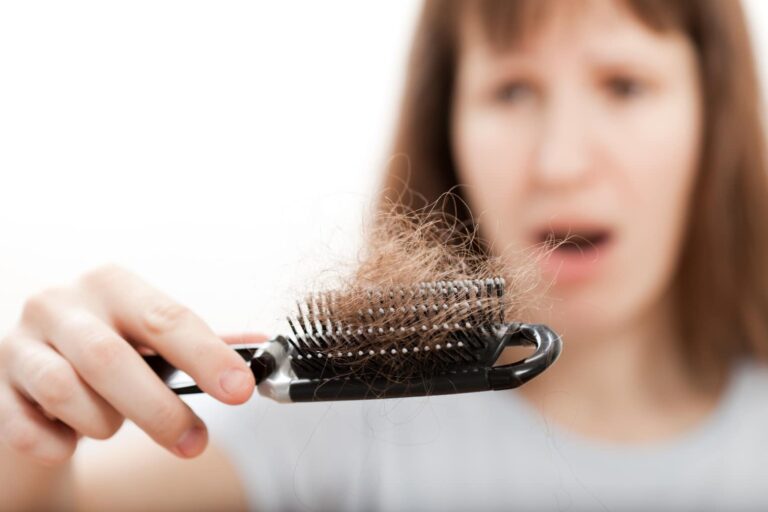As if dealing with all of the recent changes in our lives isn’t enough, many women are starting to notice hair loss. What is going ON?
There are many reasons for hair loss in perimenopause like thyroid dysfunction, low iron, high androgens, autoimmune conditions, and changes in hormone levels. But the most likely culprit right now is STRESS, especially if hair loss is a recent development.
Let’s start at the beginning. The hair growth cycle consists of three distinct stages: anagen, catagen, and telogen.
Anagen Phase
Your hair grows around half an inch a month [about 6 inches a year], and faster in the summer than in winter. The growth phase, or anagen phase, lasts an average of 3-5 years — so a full-length hair averages 18 to 30 inches. The anagen phase is generally longer in people of Asian descent, and can last as much as 7 years — meaning your hair may be able to grow up to 3 feet long!
Catagen Phase
At the end of the anagen phase, your hair enters the catagen phase. This short transitional phase lasts approximately 10 days.
Telogen Phase
Finally, your hair enters the telogen phase, a resting phase when the strands are released and fall out. The follicle then remains inactive for 3 months, before the whole process is repeated. Unfortunately, high cortisol can send hair follicles straight to the resting phase, resulting in hair loss.
What’s Cortisol Got to do With it?
Cortisol production is controlled by the hypothalamic–pituitary–adrenal (HPA) axis. It regulates the body’s reaction to stress and ensures that the body can respond immediately to stressful events and return to a normal state just as quickly. A stressful situation triggers a reaction in the hypothalamus in the brain, which then continues through the pituitary gland, and ends in the adrenal glands where cortisol, norepinephrine, and adrenaline are produced.
Your hair shafts have their own mini-HPA axis. High cortisol and norepinephrine pushes the hair into the resting phase more quickly, resulting in hair loss. This effect lasts for MONTHS (3 or more).
How do I know if I have high cortisol?
High cortisol is characterized by anxiety, heart palpitations, sugar cravings, high blood pressure, and a “wired” feeling (among other things). This can be assessed by a DUTCH test (see below). A ramped-up HPA axis looks like this graph below. This client’s cortisol and DHEA levels are through the roof and she is definitely in need of HPA calming strategies!

What’s a Savvy Sister to do?
Hair loss is one of the most frustrating experiences for midlife women. Unfortunately, there is no quick solution. The first step, if stress is the underlying cause, is to get it under control. There are many ways to do this. The key is finding what works for YOU. Here are some ideas:
- Grounding (or earthing)
- Meditation
- Prayer
- Avoiding the media
- Therapy
- Exercise
- Gratitude journaling
Once you’ve tackled step one, you may want to try adding some of the following:
- Adaptogenic herbs that are calming (like holy basil). You can find recommended brands here.
- Adding a drop or two of Rosemary or Peppermint essential oil to shampoo or a hair mask. Make sure it gets all the way to the scalp. This stimulates the hair follicles. Don’t use undiluted or you may burn your scalp. Too much may cause you to wind up with oily hair. You can find these oils here.
- Castor oil. This can be made into a hair mask that encourages hair growth. You can also use this on your eyebrows and lashes.
- Biotin. This is a B vitamin that helps hair, skin and nails.
- Collagen. You can supplement with powdered collagen or make your own bone broth.
[bctt tweet=”Hair loss is one of the most frustrating experiences for midlife women. #hairloss #stress #cortisol #perimenopause #menopause #hormones #adrenalglands #adaptogenicherbs #essentialoils #grounding #castoroil #AnnaGarrettAsheville” username=”DrAnnaGarrett”]
Dr. Anna Garrett is a menopause expert and Doctor of Pharmacy. She helps women who are struggling with symptoms of perimenopause and menopause find natural hormone balancing solutions so they can rock their mojo through midlife and beyond. Dr. Anna is the author of Perimenopause: The Savvy Sister’s Guide to Hormone Harmony. Order your copy at www.perimenopausebook.com.
Dr. Anna is available for 1-1 consultations. Find out more at www.drannagarrett.com/lets-




